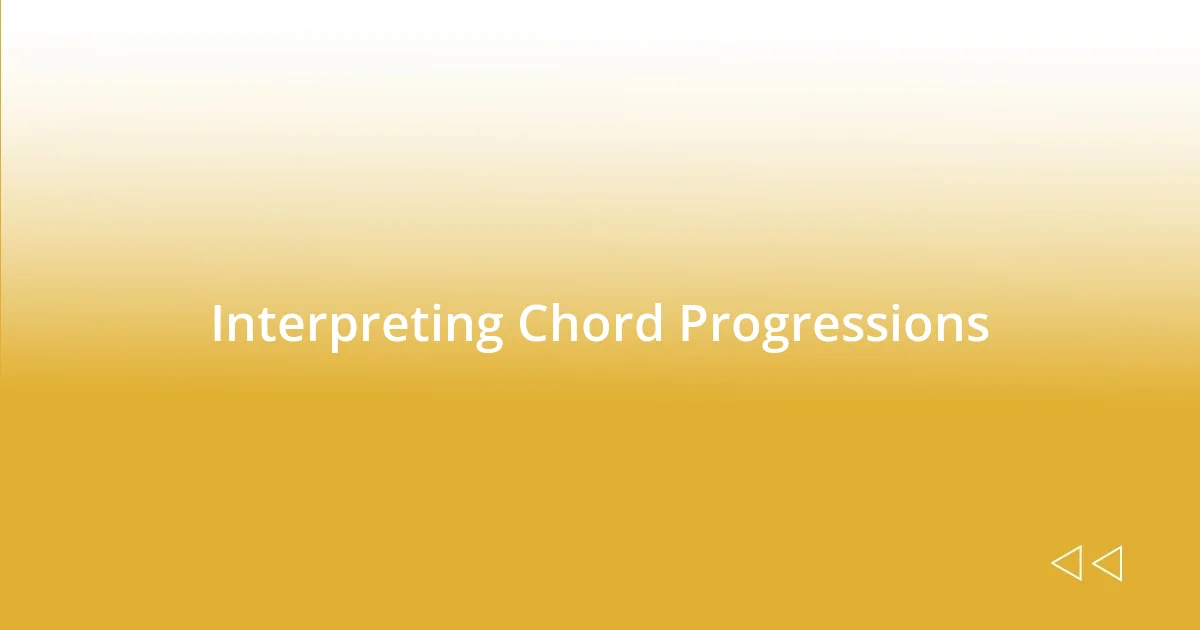Key takeaways:
- The Circle of Fifths serves as a vital tool for understanding key relationships, enhancing chord progressions, and fostering smooth transitions in music composition.
- It aids in improvisation by allowing musicians to explore adjacent keys and corresponding scales, promoting creativity and new musical ideas.
- Transposing music using the Circle can transform emotional expression, creating depth and richness by shifting between related keys and using techniques like parallel minors.

Understanding the Circle of Fifths
When I first encountered the Circle of Fifths, it was a game-changer for me. I remember staring at a chart, wondering how these simple relationships could unlock a world of music. The Circle is essentially a visual guide that illustrates the relationships between different keys, making it easier to understand how they connect and transition. Isn’t it fascinating how something so circular can open up such linear paths in composition?
Each step around the Circle represents a perfect fifth, a term that creatively illustrates harmony. As I explored these connections deeper, I realized the Circle isn’t just for musicians; it’s invaluable for anyone looking to understand chord progressions, whether you’re strumming a guitar or crafting a melody on a piano. Have you ever felt lost in a song’s key? Understanding the Circle can bring clarity, showing you not just where to go, but why those notes resonate together.
I often find myself returning to this concept when writing music; it provides a sort of musical compass. For example, if I’m composing in C major and want to explore a different emotion, I can easily find its relative minor, A minor, just a few steps away on the Circle. This interconnectedness is not just theoretical; it’s a practical tool that can elevate your musical journey. Don’t you think such insights can spark inspiration and creativity when you need it most?

Practical Applications in Composition
When composing, I frequently lean on the Circle of Fifths as a source of inspiration for exploring new harmonies. For instance, when I want a piece to move from a bright, major feel to a more somber tone, I’ll travel counterclockwise on the Circle to delve into the relative minors. This practice not only enriches my compositions but also helps to evoke deeper emotions, resonating with listeners in a way that can be both profound and transformative.
Here are a few specific ways I utilize the Circle of Fifths in my compositions:
- Chord Progressions: I create strong, engaging chord progressions by using the Circle as a guide for movement between tonic, subdominant, and dominant chords.
- Modulation: When shifting to a new key, I often reference the Circle. It simplifies transitions, making them smoother and more coherent.
- Melodic Structuring: By using intervals based on the Circle, I craft melodies that feel both fresh and harmonious, anchoring them within the established key’s emotional framework.
- Creative Exploration: If I’m stuck, I’ll randomly choose a key around the Circle and commit to writing a short piece based on that choice, pushing my creative boundaries.
Having these practical applications allows me to infuse my music with intention and feeling, ultimately crafting pieces that speak to both my experience and the emotions I wish to convey.

Enhancing Improvisation Skills
When it comes to improvisation, the Circle of Fifths serves as a fantastic foundation. I remember jamming with fellow musicians, relying on the Circle to guide our spontaneous creations. It allows me to visualize my options instantly; knowing that moving to adjacent keys can provide fresh sounds or striking contrasts keeps the music alive. Have you ever felt unsure of where to go next in your solo? The Circle can demystify those moments by clearly showing viable paths.
One of my favorite techniques is to select a starting chord and then explore its neighboring ones on the Circle. Each time I do this, I experience a new wave of excitement. Recently, I played around with a D major chord and quickly flowed into A major and B minor. The connections aren’t just theoretical; they lead to real musical dialogue among players that feels electric. Isn’t it exhilarating when a simple idea leads to an unexpected musical adventure?
To enhance my improvisation skills, I also practice playing scales that correspond with different sections on the Circle. When I do this, I discover new riffs that I hadn’t considered before. For example, while improvising over a C major progression, I might shift to the pentatonic scale of A minor, which reveals hidden melodies within the framework. This blend of structure and spontaneity helps my creativity thrive and invites those delightful “aha!” moments that every musician craves.
| Technique | Description |
|---|---|
| Choosing Neighboring Chords | Move smoothly between adjacent keys to discover fresh sounds and maintain musical dialogue. |
| Playing Corresponding Scales | Utilize scales that align with your chosen chords to uncover new melodies and enhance your improvisational flair. |

Transposing Music Using the Circle
Transposing music using the Circle of Fifths is one of those magical experiences I continuously cherish. I recall a moment when I was transposing a piece from C major to E major. Rather than getting lost in the technical side, I simply visualized the circle and shifted my focus to the relationship between these keys. It felt like flipping a switch; the music transitioned smoothly, preserving its essence while breathing new life into it. Have you ever noticed how a small shift in key can evoke a completely different feeling?
I often encourage my students to think of transposition as a journey around the Circle. For instance, if they’re stuck in one key, I suggest moving around the circle to find alternatives. Just a few steps can lead to unexpected harmonies that they had never considered. I remember working on a project where I aimed to shift from B-flat major to F major. The process of visualizing the circle helped reveal a new chord progression that turned a simple melody into something profoundly richer. It’s a game-changer when you realize that the circle has your back in expanding musical horizons.
One practical tip I often share is to utilize the parallel minor while transposing. I do this all the time—taking a major piece and dipping into its minor counterpart creates a fascinating contrast. The other day, I transposed a lively piece in G major into E minor. The dark, moody shift brought a depth that was eerily captivating. Can you imagine how exploring these relationships can transform not just your music but also your understanding of musical expression? The Circle of Fifths makes that exploration not just possible but downright thrilling.

Interpreting Chord Progressions
Understanding chord progressions can feel like piecing together a musical puzzle. When I first encountered chord sequences, I was often overwhelmed. But then, I started using the Circle of Fifths as a map. I discovered how certain chord movements, like moving from C major to G major, naturally led my compositions forward, creating tension and resolution that felt intuitive. Have you ever noticed how some progressions just seem to flow effortlessly? That’s the magic of the Circle at work, guiding you through those transitions.
One memorable experience I had was while experimenting with the jazz standard “Autumn Leaves.” As I analyzed its chord progression, I realized how it adeptly circles around the Circle of Fifths, moving through related keys. It was like unwrapping a beautifully crafted gift; each chord change revealed rich textures and emotions. I started visualizing how every chord wasn’t just an isolated event but part of a grander experience. Doesn’t it seem like every chord carries a story just waiting to be told?
When I dive into composing now, I often find myself instinctively gravitating towards progressions that traverse the Circle. For instance, moving from D minor to A major instantly evokes a sense of yearning followed by resolution, akin to a musical sigh of relief. This interplay becomes something more than just notes on a page; it invites the listener to join in an emotional journey. Doesn’t that make you think about how powerful those simple relationships can be in crafting a narrative within your music? Using the Circle helps me navigate these emotional landscapes with confidence and purpose.

Advanced Techniques for Musicians
As I ventured further into my musical journey, I found that exploring modulation through the Circle of Fifths truly elevated my compositions. I vividly remember the thrill of transitioning from C major to A-flat major in one of my pieces. It was a bold move, but visually navigating the circle made it not only possible but exhilarating. Have you ever experienced that rush when shifting keys opens up a whole new emotional palette?
While practicing complex jazz chords, I learned to embrace the concept of secondary dominants. I recall the moment I decided to apply this technique; adding a D7 before resolving to G major transformed a simple melody into something rich and dynamic. This subtle use of the Circle can really inject life into your arrangements, don’t you think? It turns out, these tiny adjustments can lead to surprising results that engage listeners in a profound way.
I often experiment with voice leading while using the Circle of Fifths, guiding smoother transitions between chords. There was a time I was crafting a piece and realized how seamlessly I could connect G major to E minor—almost like following a thread through an intricate tapestry. It made me wonder: isn’t it fascinating how the relationships among chords can create an emotional thread that resonates deeply? By embracing these advanced techniques, I continually discover new ways to articulate my musical ideas. Each experiment feels like peeling back a layer, revealing fresh expressions just waiting to be uncovered.















